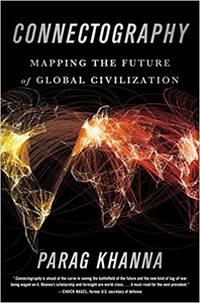Book Review of “Connectography: Mapping the Global Network Revolution” by Parag Khanna
Reviewer, Mark D. Walker
 “Connectography” helped me understand, “which lines on the map matter most” in this complicated and ever changing world we live in today. The author explains why the borders we’re used to focusing on have become irrelevant in understanding the new directions foreign trade and foreign affairs are taking. Khanna guides us through emerging global networks in which mega-cities compete for the market share.
“Connectography” helped me understand, “which lines on the map matter most” in this complicated and ever changing world we live in today. The author explains why the borders we’re used to focusing on have become irrelevant in understanding the new directions foreign trade and foreign affairs are taking. Khanna guides us through emerging global networks in which mega-cities compete for the market share.
A series of innovative maps depict these new trends of connectivity. Maps which go beyond the normal nation-state divisions, but include supply chains and trade linkages which reveal important cultural and economic changes. Maps include a global distribution of total economic wealth by continent, climatic changes and areas where greenhouse gas emissions rise from.
Some of Khanna’s predictions are as bold as they are insightful, “The most significant and geopolitical interventions will prove to be not military but infrastructural.” He points out that the Indian Ocean is the epicenter of competitive connectivity and that Dubai is the “defacto capital” of the Middle East and the epicenter of free zone development.
Khanna also shows the “underbelly” of these impressive trends, which include an estimated forty million people enslaved as bonded laborers around the world, with over half of them in four countries: India, Pakistan, Russia and China. Economic growth and connectivity also leads to more corruption, which rears its ugly head in this more connected world where both India and Russia are crippled by corruption. India loses an estimated $100 billion a year in illicit capital outflows. Africa loses twice as much each year in corruption and tax evasion as it receives in aid.
The author sheds light on the growing disparity between the “haves and have nots” where he indicates that 1 percent at the top are controlling half the total wealth while half the world’s people earn about $2.50 a day or less. He goes on to say that the world economy will continuously struggle to sustain any long-term growth until this pyramid becomes a diamond.
Nation states are seen as “passe”, as a series of other factors is driving the changes in our world, and if we’re to have any control over these changes we’ll need to understand them first and focus on the factors which are driving what and how the world economy and population changes are occurring. One important takeaway is that infrastructure is destiny—follow the supply lines. Coca Cola and DHL are the examples of how all-encompassing these supply lines can be.
The author is a global strategist, world traveler and bestselling author. He’s a CNN Global Contributor and holds undergraduate and graduate degrees from the School of Foreign Service at Georgetown University and a Ph.D. from the London School of Economics.
I highly recommend this book for anyone who wants to understand how mankind is reengineering the planet by investing trillions each year on transportation, energy and communications linking the world’s burgeoning megacities together. All of this has profound consequences for geopolitics, economics, demographics, the environment, and social identity. After reading this book we can all appreciate why connectivity, not geography, is our destiny.
Hardcover: 496 pages
Publisher: Random House (April 19, 2016)
Language: English
ISBN-10: 0812988558
ISBN-13: 978-0812988550
Product Dimensions: 6.5 x 1.5 x 9.6 inches
Shipping Weight: 1.8 pounds (View shipping rates and policies)
Average Customer Review: 4.3 out of 5 stars 101 customer reviews
Amazon Best Sellers Rank: #42,034 in Books (See Top 100 in Books)